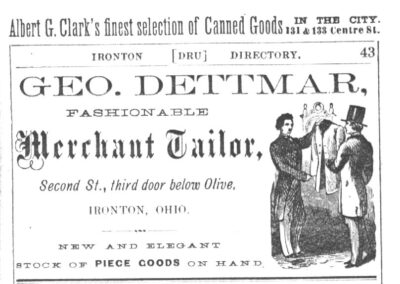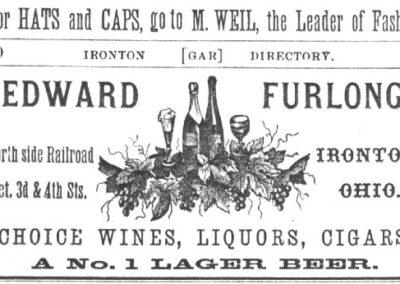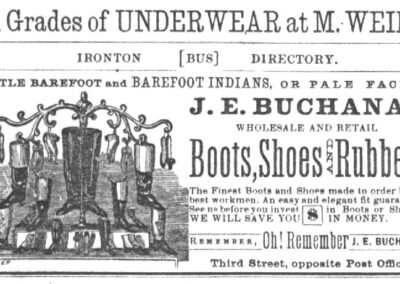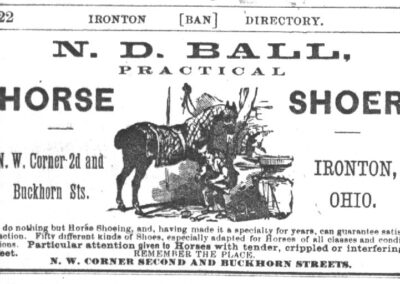IRONTON, OHIO FIRES – TWO BUSINESS BLOCKS IN RUINS
THE GREAT FIRE
(pen sketch “After The Fire”)
This series compiled by: Sharon Milich Kouns
Ironton Register, February 16, 1888
The Most Destructive Fire in Ironton, Ohio, Ever Had – Incidents, Losses, Prospects, and Personals.
Last Sunday morning, a few minutes before one, the fire whistle shrieked and told off Third Ward; again, it blew long and angrily and followed a general alarm. That warning roused the sleepy citizen to the terrors of a dreadful conflagration and looking out the window on the white earth and icy trees.
He could see right in the center of town the red flames leaping high and gathering strength in the heavy folds of smoke as they drifted into the black sky. And then there was hurrying across the snow and the soft jingling of the bells of the hose carriages, but scarce a shout was heard to break the stillness of that spectral scene. It was a time to appall and not to alarm.
Merchant’s block was on fire, the very center of the business portion of town, and the central house of the block was filled with seething, raging flames that burst from roof and windows before the whistle pierced the air with its fearful message. Merchants block is a three-story stone front on Second-st., built-in 1872 by S. B. Steece, H. B. Wilson, and Bartram & Peters. The latter firm holds the house they built on the corner and is occupied on the first floor by the Giant clothing house.
Mr. Wilson sold to Mr. Nixon, who conducts a furniture business in his three stores. Mr. Steece sold to S. W. Dempsey the three center houses, which now belong to that estate. The middle was occupied by Dawson & Powers’ bookstore, where the fire broke out; Mittendorf, Gabler & Co.’s dry goods store on the right and Weil’s clothing store on the left. Over the bookstore and the Weil store, in the third story, was the Odd Fellows hall.
Over the Giant clothing store, Mrs. Wm. Nixon lived, and Dr. Miller had his dental rooms. Over Mittendorf’s were a club room with a billiard table and gymnastic apparatus. Back of this block and fronting on Center was the Masonic Opera building, occupied by McQuigg’s hat store, Otten & Tyler’s drug store, the Post Office, a barber shop, Dr. J. M. White’s office, and the Board of Education’s office. In the latter were the books of the Briggs library. The Masonic hall and the Knight Templar’s camp were also in this building.
The fire involved all the buildings we have noted and drove out every occupant we have named, though in the case of D. Nixon’s furniture store, that might have remained without damage, but the stock was all removed as a precaution. Mrs. Drury’s millinery store, next to Mr. Nixon, was unharmed.
The fire department was prompt at their post and worked like heroes from the start. But the books, the paper, the very tinder of a bookstore, where the fire first appeared, fed the flames with a flood that intensified their voracity, and they were shooting through every story by the time the water began to play upon them.
Doorways leading from Dawson & Powers’ building into Mittendor’s on the second and third floors, a combined roof covering these two and the building where Weil’s store was, and a skylight in each building made easy avenues for the flames from one to another, and so widened the scope of the fire and hid the fierce work that the streams of water were no match for it. While the firemen were doing their best, the three buildings became a vortex of lurid heat that undermined the walls, lifted the tin roof, and waved it high in the air as if it were paper.
There was a firewall between the Weil building and the Bartram & Peters, but so fierce was that solid mass of flame that it got over and around and invaded every part of that beautiful building. It was not long before these four buildings were only walls with a sea of flame within, and then the walls began to tumble as the fire fiend completed his work.
But all the time, Nixon’s building was intact. The flames swept high up its firewall, crept around its cornice, and hurled their keen javelins at every weak spot. Still, with a nozzle in his hand, a brave fireman stood on the edge of that roof, at the margin of that sea of fire whose spray of livid heat dashed into his face and fought those flames like a tiger.
At times, they seemed too much for him and would push him back, but with renewed courage, he sprang to the onset again, and they recoiled to gather strength to spring on him again. Thus the duel kept up, with uncertain results, until finally, the splendid bravery and endurance of the fireman were victorious, and Nixon’s building was saved.
In the meantime, the danger had extended to the Masonic building. Between the rear wall of the Merchants block and the sidewall of the Masonic building is a distance of about five feet, except at the rest of the Bartram & Peters’ building, there is a space of only two or three inches between the walls. Across this passageway of five feet, the flames of the burning block leaped to the windows of the Masonic, caught under the cornice and rafters, and soon overspread the entire framework on which rests the roof of the Masonic building.
Desperate efforts were made by the firemen, who had left Merchants block to rescue the Masonic, to dispute the progress of the flames into the Opera House. But the conditions were all against the firemen. Though they were daring and venturesome, attacking the fire from every available standpoint, inch by inch, the ferocious element ate its way until under the roof was a fiery furnace that made the tin roof glow like red hot iron.
Presently there was a crash, and down came the roof and ceiling on the floor of the Opera House, crushing chairs, scenery, tables, etc., in the fall. But so persistent had the water been thrown into the Opera House that the floor was fairly covered with it, and the burning beams and rafters were soon extinguished. In the fall, a small section of the wall next to Merchants block fell out; but beyond that, little, if any, the damage was done to the walls of the building.
The Masonic hall in the third story in front of the auditorium met a similar fate. The roof, and rafters, charred and soaked with water, lie on the hall floor, making a very discouraging scene. The steps to the auditorium and Masonic hall gallery were badly burned, though not consumed. The falling roof crushed the chairs in the parquette, but none of those in the dress circle under the gallery were injured.
All the grand scenery – the palaces, woods, beautiful streams, and stately bridges – were swept by the fire or irreparably mutilated by the water. It is thought the walls, with the slight exception mentioned, are thoroughly sound and that except for the destruction done by the water and falling timbers, there is no serious damage done in the lower hall of the building.
At times, while it was ablaze and the flames shot from the roof, the scene was fearfully grand. it lighted the whole town and betokened for a while the complete destruction of the Masonic. Still, here again, the firemen worked in smoke, shower, and danger, contending with the fire fiend for mastery over that splendid edifice.
It was over two hours from the time that the alarm was given till the great danger was past. The night was a quiet one. The flames and sparks shot straight up. Otherwise, the blocks across the street would have been joined in the disaster. As it was, so strong was the flame that shot out of the windows and roof, and the windows in the Center block were so hot as to burn one’s fingers. A little breeze would have carried destruction a good deal further.
This great disaster has left an unsightly ruin in the midst of our city. Three stores are completely wiped out, a fourth very seriously damaged, and two driven into transient quarters. The community universally deplores the sad havoc in our business arena but hopes and believes that out of it will arise, at least, as good buildings and cheerful prospects as before.
NOTES
The post office sustained no loss.
- Barrette photographed the ruins before the stone front was torn down.
- John Fulwiler says he saw the fire first when it was but a small blaze, apparently in the rear of the stairway in the back of Dawson & Powers’ store. This was 15 minutes to 1. James Alexander was the next to see it. John ran toward the telephone exchange, then, changing his mind, started to the 3rd ward hose house and shouted to some men nearby to ring the bell.
- Bert Miller, the actor who comes to play “Dixie” with the Kirker Rifles, got here on the midnight train and then went out and saw the Opera House burn up.
- McQuigg & Co. are established in Hayward’s new building for the present.
- Otten & Tyler rented the Davidson bookstore stand while the fire was in progress and immediately moved in.
- At Weil’s store, the doors were not unlocked after the fire broke out. Nothing was saved. Cal Brooks arrived on the scene as the floors were caving in and, a few hours afterward, extracted the books and insurance policies from the safe in the cellar.
- Norton & Co. saved the “Royal Bumper” from the Masonic lodge and placed him on exhibition.
- Harry Amlin and the Nixon boys escaped with a suit of clothes apiece.
- Mart Hall stayed with the hose nozzle in a closed place til he had to be carried out.
- Fulwiler’s wheezes and yells aroused Dr. White as he raised the alarm. He spent valuable time opening his safe, and much of his furniture was damaged.
- Willing hands, directed by Col. Gray, hustled the Briggs library books to a safe place.
- When the Opera House curtain fell, it spread nicely over the stage carpet and piano and saved them.
- Mrs. Nixon’s loss is a severe one. She had rooms over the Giant store and a large amount of furniture, bedding, and tableware in front of the boarding house, which she kept in Cincinnati, stored away on the third floor. Her loss estimate is low, at a thousand dollars, and there was no insurance. A square piano was among the articles burned. Only a small amount of furniture and clothing were saved.
- Dr. Miller’s insurance would have expired at noon Sunday, and he had arranged for a larger amount.
- Iron City Lodge, I. O. O. F., who had their hall over Dawson & Powers’ and Weil’s stores, lost everything in the rooms – carpets, furniture, charter, paraphernalia, and record books, of which the latter were, of course, the most valuable. The record book of the district committee was also burned. The lodge room had recently been fitted at considerable expense to the order.
- The Post Office was in great demand Sunday morning when a new location seemed probable.
- It is suggested that Merchant’s block be rebuilt as a hotel, with store-rooms and the office on the ground floor, and the hotel on three floors above.
- “There is a good place now,” said a prominent Odd Fellow, “for an Odd Fellows building.”
- Mr. Mittendorf says his firm had a $21,000 stock on hand and saved a thousand dollars worth, which is now piled helter-skelter in Murdock’s building.
- The senior member of the firm of Dawson & Powers started home with Cal Brooks the night before the fire and, when some distance away, remembered that the safe was open and went back and shut it. The safe passed through the fire and saved the insurance policies.
- Scores of Ashlanders came down to see the ruins.
- D. Nixon’s goods were damaged by $250 worth by removal.
- The P. O. resumed at the old stand under the temporary roof Monday morning without a letter or a paper misplaced. The Second National Bank was the post office for a short time on Sunday. Bickmore’s store accommodated the boxes.
- The Giant stock went to Alderman’s residence and the 5-cent store.
- The Masons saved their record books, charter, lodge furniture, and jewels.
- C. A. Alderman stood on his roofs for three hours, watching his property and beholding the conflagration.
- Mittendorf & Gabler wish us to thank the firemen and other friends for their daring efforts on their behalf.
- The Knights Templar met with a sad loss. They had fitted up an elegant asylum and expended nearly $600 on it, which expense the fifteen or twenty members in Ironton themselves bore. They had just got things in nice working order when the fire swept away everything they had. They didn’t save a thing except for the banners. Of course, each Knight feels quite torn up, but they propose to go to work and restore their asylum to its youthful beauty as soon as possible.
- The cause of the fire is not known. It started near the stairs in the back of Dawson & Powers bookstore, and no further explanation was given.
- Col. Williams was in Cincinnati at the time.
- About 20 special police guarded the ruins.
- When and how will the block be rebuilt? The Masonic will soon be restored.
- Our picture of the ruins is from a photograph by Mr. Barrette and is engraved by Mr. Favre, the accomplished artist of the Portsmouth Blade. The reader can get a good idea of the fire from this faithful picture.
- The dentist, Dr. Miller, will visit Cincinnati to get a new outfit and locate Alderman’s store.
- The Insurance Adjusters are on hand promptly and are ready to do their part. The absence of Col. Williams deters action. Already three adjustments have been…
MORRIS BLOCK DESTROYED
I. R. Jan. 14, 1892
(pencil sketch – heading MORRIS BLOCK IN FLAMES. – We give above a picture of the Morris block fire, made when the conflagration was at its height and when the wall started to fall. It was a thrilling moment just then. The interior of the building was a sea of flame, and the great sparks floated far away in clouds. Mr. Ricker hastily drew the sketch, and it will serve to show our readers the force and extent of the disastrous fire.)
On the 4th, a fire at Morris block was extinguished before it did a great deal of harm. On the 8th, the fire broke out again and destroyed the block. The alarm was sounded at 5 a.m., but before the fire companies got there, and they were prompt, the building was doomed. The part occupied by Fletcher’s store and furniture was filled with flame, and in a few minutes, the entire block was enveloped, and a great volume of flame issued from the building, causing the roof, floors, and walls to tumble. So hot were the flames that the awnings on the opposite side of the street caught fire, and the heat broke the plate glass in the bookstore and ladies’ storefronts.
The fire companies did all that was possible, and the fire did not even greater destruction, was due to their vigorous efforts. Six streams were constantly thrown on the flames or turned on the adjacent property as occasion demanded. When the west wall of the block tumbled, it crashed into a frame building belonging to E. Bixby and occupied by Esq. Henry. The firemen saved Mr. Weiler’s house close to the Morris block, but the interior got a good wetting.
All the property of the K. of P. in their hall in the third story; all of Fletcher’s furniture and goods; all the type, presses, stock, and material of the Republican offices were destroyed. And the block itself is a complete wreck. The East building of the block is standing, but it is a mere shell and will be removed. The block was insured for $9,000, the Republican office for $3,500, and Fletcher’s for $3,500.
The cause of the fire seems to have been merely a revival of the conflagration four days before.
MEMORIAL HALL AND BRIGGS LIBRARY FIRE
I. R. Jan. 11, 1906 – Insurance Paid. – The insurance of $2000 on the Briggs Public Library, recently destroyed by the Memorial Hall fire, was paid Saturday in full.
The insurance was carried by the Hartford and Franklin Companies, represented by T. I. Collett of this city. The total loss on the library was about $4400.





0 Comments